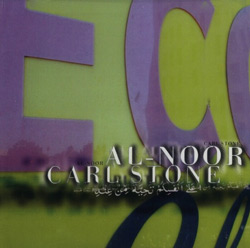
When roundtable discussion comes around to contemporary maestros of sampling dexterity — those electroacousticians operating at the cross-juncture of musique concréte, jumpcut/edit techniques, and a laptop’s engulfing domain — it’s rare that Carl Stone’s name arises swiftly to the top. Too often relegated to the sterile hallways of academia and stuffed shirt electronic “classicism,” Stone’s operational methods defy such rigid orthodoxy; his best recordings emphasize “place,” even when such places are refracted off a motherboard’s forest of diodes. It’s also somewhat misleading to label Stone as a mere “samplist” — unlike a typical hip-hop producer or soft synth bedroom boffin, he doesn’t appropriate existent sounds for lack of compositional ability (he’s a bona fide sound designer in his own right), or to whip out saddle-stitched neo-collages, but instead reorients both the listener’s and computer’s basic paradigms.
Nevertheless, even as a longtime admirer and collector of Stone’s work over the years (his earlier Mom’s and collaboration with Tetsu Inoue, Pict Soul, are particularly notable classics), and as superbly executed as Al-Noor is, some sense of disappointment ebbs out of the grooves to these ears. Yes, there are indeed grooves here, as Stone makes vibrantly clear while weaving Cairo-inflected streetspeak into an Arabic parade throughout “Flint’s”, and creating a symphony of cycling echo on “Jitlada,” wherein looped phraseologies duke it out in a swirling mélange of dizzying semi-quavers and semi-beats. Yet, somehow, the whole enterprise isn’t particularly, well, awry enough, at least by past Stone standards, and therein lies the rub.
That being said, Al-Noor, is partially redeemed when Stone flexes his staunchest deconstructionist muscles on the 24-minute final track, “L ‘Os ‘a Moelle,” which, surprisingly, doesn’t take you where you think it wants to go. Repeating ad infinitum a loop of what sounds like some unreleased Byrds psychsong from the 60s, Stone gradually shifts the ringing guitars slightly out of phase until the whole thing practically spins off its axis like some aural tilt-a-whirl. Filtering the likes of an apparent rock “chestnut” through a sieve of unpretentiously avant-gardian schema paints Stone as a sonic provocateur easily the peer of colleagues (and mentors) John Cage and James Tenney. At first glance the breezy rock motifs appear grossly out of place, until Stone incrementally shifts the tonal centers, achieving a queasy gestalt that muddies your equilibrium better than a fifth of scotch, until the guitars sound as if they’re getting mangled in a sausage grinder. Eventually Stone morphs the piece into something resembling a raga that narcotizes as much as it hypnotizes, 21st century Carnatic music glimpsed through a purple haze.
Comments and Feedback:
|



